Cardiac Function & Myocardial Perfusion
Oral
Cardiovascular
Tuesday, 19 June 2018
| N01 |
08:15 - 10:15 |
Moderators: Bettina Baessler, Krishna Nayak |
08:15
|
0358.
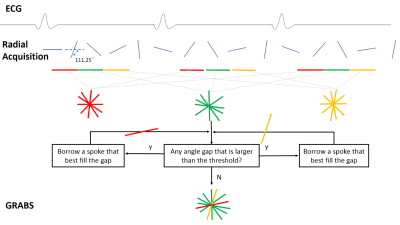 |
 Improved 2D cardiac Cine MRI with retrospective gating using Golden-angle Radial acquisition and Angle-Based echo-Sharing (GRABS) Improved 2D cardiac Cine MRI with retrospective gating using Golden-angle Radial acquisition and Angle-Based echo-Sharing (GRABS)
Qi Liu, Yu Ding, Jingyuan Lyu, Lele Zhao, Yanqun Teng, Jian Xu
Cardiac Cine MRI with retrospective gating using Golden-angle Radial acquisition and Angle-Based echo-Sharing is a promising technique permitting retrospective gating, arbitrary temporal resolution, and arrhythmia data rejection. It is an easy-to-implement and effective technique that features improved image quality by reducing streaking artifacts.
|
08:27
 |
0359.
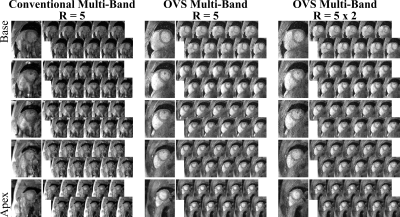 |
 Feasibility of Ultra-high Simultaneous Multi-slice and In-plane Accelerations for Cardiac MRI Using Outer Volume Suppression and Leakage-Blocking Reconstruction Feasibility of Ultra-high Simultaneous Multi-slice and In-plane Accelerations for Cardiac MRI Using Outer Volume Suppression and Leakage-Blocking Reconstruction
Sebastian Weingärtner, Steen Moeller, Mehmet Akcakaya
Simultaneous multi-slice (SMS) imaging has gained increasing interest for enabling high scan-time acceleration at the cost of minimal loss in SNR. However, its applications in cardiac MRI have been limited, as the feasible acceleration is restricted by unfavorable coil geometry. In this study, we investigate the use of outer-volume suppression (OVS) in combination with CAIPIRINHA to promote dissimilarities among the multi-bands. We propose a time and SAR efficient multi-band scheme for OVS and apply these techniques with a leakage blocking reconstruction to increase the feasible acceleration in cardiac cine and perfusion imaging. Combining these techniques, we achieve clinical image quality with 5 fold SMS acceleration in Cine and 16-fold spatial-only acceleration in perfusion MRI.
|
08:39
|
0360.
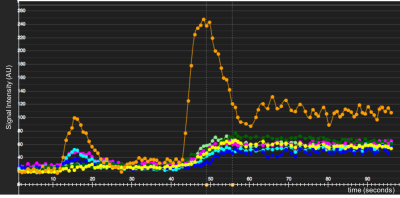 |
 Feasibility of absolute myocardial blood flow quantification using Simultaneous Multi Slice (SMS) SSFP first-pass myocardial perfusion imaging and iterative reconstruction at 1.5 Tesla. Feasibility of absolute myocardial blood flow quantification using Simultaneous Multi Slice (SMS) SSFP first-pass myocardial perfusion imaging and iterative reconstruction at 1.5 Tesla.
Muhummad Sohaib Nazir, Radhouene Neji, Peter Speier, Daniel Staeb, Michaela Schmidt, Christoph Forman, Reza Razavi, Sven Plein, Tevfik Ismail, Sebastien Roujol, Amedeo Chiribiri
Quantification of myocardial blood flow (MBF) enhances diagnosis and provides prognostic information. Simultaneous Multi Slice (SMS) imaging allows greater spatial coverage of the heart with minimal signal-to-noise penalty and is thus desirable for perfusion imaging. 5 patients underwent two rest perfusion scans using a dual-bolus technique with SMS protocol (6 slices) and iterative reconstruction and standard 3 slice bSSFP sequence. Absolute MBF was quantified with a fermi-constrained deconvolution algorithm. Global and territorial MBF was comparable between the different methods. Future evaluation in patients with stress testing and greater heart coverage may provide clinical utility in patients with coronary artery disease.
|
08:51
|
0361.
 |
 Improving compressed sensing reconstructions for myocardial perfusion imaging with residual artifact learning Improving compressed sensing reconstructions for myocardial perfusion imaging with residual artifact learning
Ganesh Adluru, Bradley Bolster, Jr., Edward DiBella, Brent Wilson
Compressed sensing/constrained reconstruction methods have been successfully applied to myocardial perfusion imaging for improving in-plane resolution and improving slice coverage without losing temporal resolution. However at high acceleration factors and in the presence of large inter-time frame motion image quality from the CS methods is affected. Here we propose an artifact learning neural network that aims to improve the image quality of spatio-temporal constrained reconstruction methods for gated Cartesian and ungated radial data. Promising results are shown on datasets that were not used in training the neural network.
|
09:03
 |
0362.
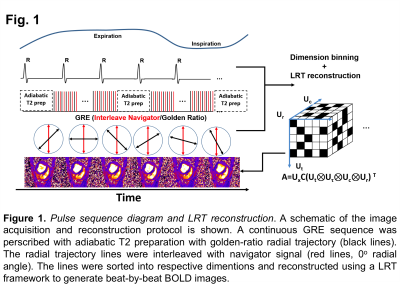 |
 Beat-by-Beat Dynamic Assessment of Myocardial Oxygenation with Highly Time-Resolved, Free-breathing, Ungated Cardiac T2 BOLD MRI Using a Low-Rank Tensor Formulation Beat-by-Beat Dynamic Assessment of Myocardial Oxygenation with Highly Time-Resolved, Free-breathing, Ungated Cardiac T2 BOLD MRI Using a Low-Rank Tensor Formulation
Hsin-Jung Yang, Anthony Christodoulou, Jane Sykes, Xiaoming Bi, Ivan Cokic, Frank Prato, Debiao Li, Rohan Dharmakumar
Coronary vasodilation and the ensuing myocardial hyperemia following the administration of a provocative stressor is a dynamic process. However, established perfusion methods are confounded by contrast accumulation and lack the temporal resolution to accurately evaluate the process. BOLD CMR is an emerging method for monitoring myocardial perfusion without contrast agents, but the current methods are slow. We developed a non-ECG-gated, free breathing, beat-to-beat, cardiac/respiratory phase-resolved, T2-based BOLD CMR sequence at 3T using a low rank tensor framework to enable highly time-resolved assessment of coronary reactivity. We tested the proposed technique in an animal model with and without coronary disease.
|
09:15
 |
0363.
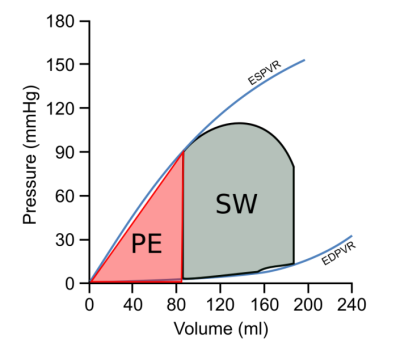 |
 Non-invasive pressure-volume loops from cardiovascular magnetic resonance and brachial pressure Non-invasive pressure-volume loops from cardiovascular magnetic resonance and brachial pressure
Felicia Seemann, Per Arvidsson, David Nordlund, Sascha Kopic, Marcus Carlsson, Håkan Arheden, Einar Heiberg
Cardiac pressure-volume loop analysis provides important information on cardiac function, but is currently not widely utilized clinically since invasive measurements are required. This study aimed to develop and validate a non-invasive method of estimating pressure-volume loops, via a model-based framework using cardiovascular magnetic resonance. The method yields individualized pressure-volume loops computed using time-varying elastance, with left ventricular volume and brachial pressure as input. Experimental validation showed strong agreement to in-vivo measurements, and application to healthy controls and heart failure patients yielded expected results. Hence, the model is a promising method for obtaining pressure-volume loops from magnetic resonance imaging.
|
09:27
|
0364.
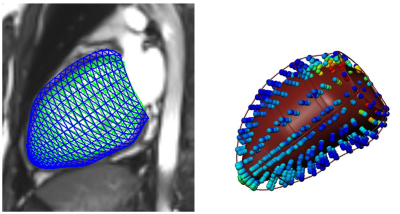 |
 Subtle changes in hyperelastic properties of myocardium with cardiotoxicity remodeling from CMR Subtle changes in hyperelastic properties of myocardium with cardiotoxicity remodeling from CMR
Delphine Perie-Curnier, Marianna Gamba, Marilou Trempe, Jenny Wang, Martyn Nash, Alistair Young, Daniel Curnier
The aim of this study was to assess subtle changes in 3D geometrical and mechanical properties of left ventricle in childhood acute lymphoblastic leukemia survivors. Global 3D volume or ejection fraction were not sensitive enough while time dependent 3D geometrical parameters over the cardiac cycle showed that early diastole is more affected than systole or late diastole. Smaller hyper-elastic properties were found in the high risk group than in the standard risk, high risk with cardioprotective agent or healthy volunteers group. High temporal resolution and local parameters would improve the detection of these subtle changes.
|
09:39
 |
0365.
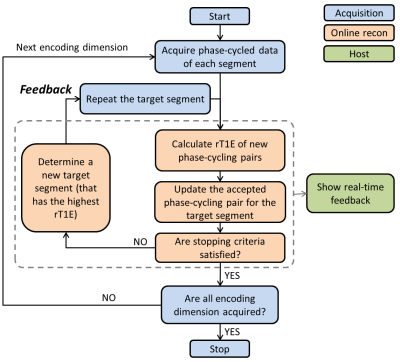 |
 Self-gated free-breathing cine DENSE imaging by adaptively reducing residual T1-echo energy Self-gated free-breathing cine DENSE imaging by adaptively reducing residual T1-echo energy
Xiaoying Cai, Frederick Epstein
Cine DENSE is a well-established myocardial strain imaging technique that typically requires breath-holding. In this study, we developed a self-gated free-breathing adaptive acquisition algorithm that reduces free-breathing artifacts by minimizing the residual energy of the phase-cycled T1-relaxation signal. The algorithm adaptively repeats the acquisition of the k-space data with the highest residual T1-echo energy. Evaluation in 7 healthy subjects demonstrated that the method provides high quality free-breathing self-gated cine DENSE images in a clinically-reasonable scan time.
|
09:51
 |
0366.
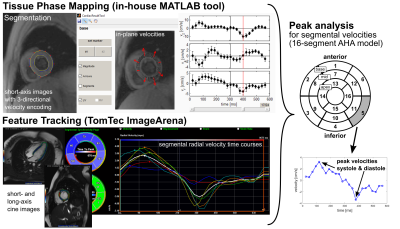 |
 Assessment of Regional Myocardial Velocities by Tissue Phase Mapping and Feature Tracking in Healthy Children and Pediatric Patients with Hypertrophic Cardiomyopathy: A Comparison Study Assessment of Regional Myocardial Velocities by Tissue Phase Mapping and Feature Tracking in Healthy Children and Pediatric Patients with Hypertrophic Cardiomyopathy: A Comparison Study
Alexander Ruh, Arleen Li, Joshua Robinson, Cynthia Rigsby, Michael Markl
In this study, we compare tissue phase mapping (TPM) and feature tracking (FT) of standard cine SSFP images for the assessment of regional myocardial velocities in 15 pediatric patients with hypertrophic cardiomyopathy (HCM) and 20 age-matched healthy controls. Data analysis included the calculation of segmental (AHA 16-segment model) left ventricular radial and long-axis peak velocities in systole and diastole. Both techniques detected significantly decreased diastolic velocities in HCM patients compared to controls, suggesting reduced myocardial relaxation despite normal ejection fraction. Lower temporal resolution of FT derived velocities resulted in systematically lower peak velocities compared to directly measured TPM velocities.
|
10:03
|
0367.
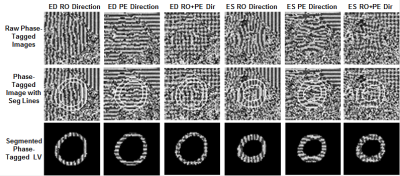 |
 Cardiac Single Breath-hold Balanced SSFP Cine ‘Watermark’ provides Cardiac Function via Magnitude and 2D Myocardial Strain via Phase Cardiac Single Breath-hold Balanced SSFP Cine ‘Watermark’ provides Cardiac Function via Magnitude and 2D Myocardial Strain via Phase
Ronald Beyers, Nouha Salibi, Thomas Denney
Cardiac MRI myocardial tagging enables quantification of myocardial strain. However, tagging remains limited to a research context due to the time-intensive analysis and need to run multiple sequences. CMR sequences must be fast and efficient. We previously developed a FLASH-based cine sequence called Cine ‘Watermark’ (CWM) that acquires normal cine magnitude images plus ‘hidden’ (via phase) cardiac strain data for calculating myocardial strain. Here we present a Balanced SSFP (bSSFP) version of CWM that presents improved SNR and scan efficiency. The bSSFP CWM is demonstrated in human subjects at 3T and its performance is compared to conventional Grid-Tagging MRI.
|
|













